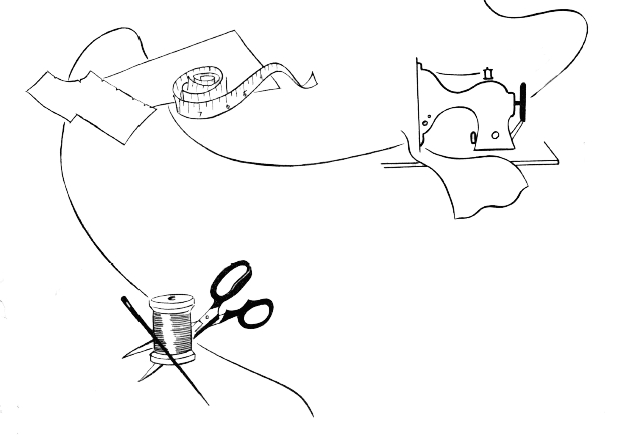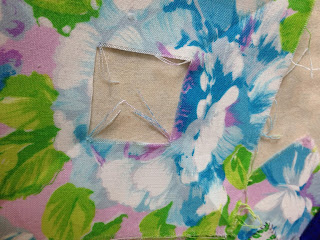|
We have made it to the end of my interminable PDf series! (There will be one final post with a big surprise though...)
So this is the thirteeth and final post of collections of DOWNLOADABLE PDF pamphlets. I have gathered these from around the web - almost entirely from various American university cooperative extension programs or university archives of such. (If you are not familiar with extension programs, they are pretty cool. They date back to 1914 and are the precursor to community colleges.)
Please note that these are historic resources. They may refer to methods and items that are no longer sold or considered safe (home dry cleaning with gasoline, I'm looking at you). Do not follow such advice without exploring modern resources and using your best judgement. This batch I have three lists as follows. Enjoy.
Fabric Tips Wovens & Non-Wovens; General Fabric Info |
|||
|---|---|---|---|
| Year | Title | Author | Publisher |
| 1950 | Rayon Dress Fabrics: Their Selection, Behavior, Care | Elizabeth M. Birong | Montana State Univ. |
| 1954 | Sewing the New Fabrics | -- | Univ. of Nebraska, Lincoln |
| 1954 | Man-Made Fibers and Fabrics | Helen Rocke | Univ. of Nebraska, Lincoln |
| 1956 | Suggestions for Sewing the Newer Fabrics | Julie E. Brekke | North Dakota State Univ. |
| 1965 | Wash and Wear Fabrics | Gerda Petersen | Univ. of Nebraska, Lincoln |
| 1965 | Laminated and Bonded Fabrics | Gerda Petersen | Univ. of Nebraska, Lincoln |
| 1965 | Leather | Gerda Petersen | Univ. of Nebraska, Lincoln |
| 1965 | Stretch Fabrics | Gerda Petersen | Univ. of Nebraska, Lincoln |
| 1969 | Vinyls and Simulated Leathers | Gerda Petersen | Univ. of Nebraska, Lincoln |
| 1969 | Sheers | Gerda Petersen | Univ. of Nebraska, Lincoln |
| 1969 | Laces | Gerda Petersen | Univ. of Nebraska, Lincoln |
| 1972 | Durable Press | Gerda Petersen | Univ. of Nebraska, Lincoln |
| 1977 | Working with Leather | Jane Speece | Univ. of Nebraska, Lincoln |
| 1985 | Wool and Wool Blends | Rose Marie Tondl | Univ. of Nebraska, Lincoln |
| 1986 | Sewing the Silkies | Rose Marie Tondl | Univ. of Nebraska, Lincoln |
| 1988 | Sewing with Denim | Rose Marie Tondl | Univ. of Nebraska, Lincoln |
| 1991 | Sewing with Micro-Fibers | Rose Marie Tondl | Univ. of Nebraska, Lincoln |
| 1991 | Micro-Fibers | Rose Marie Tondl | Univ. of Nebraska, Lincoln |
| 1997 | Tencel Lyocell, the New Generic Fiber | Rose Marie Tondl | Univ. of Nebraska, Lincoln |
| 2000 | Sewing With Voile | Rose Marie Tondl | Univ. of Nebraska, Lincoln |
| 2000 | Sewing with Velveteen | Rose Marie Tondl | Univ. of Nebraska, Lincoln |
| 2000 | Sewing with Velvet | Rose Marie Tondl | Univ. of Nebraska, Lincoln |
| 2000 | Sewing with Microfibers | Rose Marie Tondl | Univ. of Nebraska, Lincoln |
| 2000 | Sewing with Tencel | Rose Marie Tondl | Univ. of Nebraska, Lincoln |
| 2000 | Sewing with Lycra Blends | Rose Marie Tondl | Univ. of Nebraska, Lincoln |
| 2000 | Sewing with Outerwear Sports Fabric | Rose Marie Tondl | Univ. of Nebraska, Lincoln |
| 2000 | Sewing with Rayon Challis | Rose Marie Tondl | Univ. of Nebraska, Lincoln |
| 2000 | Sewing with Sand-Washed Fabrics | Rose Marie Tondl | Univ. of Nebraska, Lincoln |
| 2000 | Sewing with Silky-Textured Fabrics | Rose Marie Tondl | Univ. of Nebraska, Lincoln |
| 2013 | The Burn Test | from Mary Elliott, Elaine Zarse | Threads Magazine |
Fabric Tips: Interfacing |
|||
|---|---|---|---|
| Year | Title | Author | Publisher |
| 1962 | Interfacing | Marian Tudor, Freda Record | North Dakota State Univ. |
| 1966 | Interfacings | Gerda Petersen | Univ. of Nebraska, Lincoln |
| 1981 | Selecting and Using Interfacing | Marilyn Stryker | Kansas State Univ. |
| 1993 | Interfacings | Gerda Petersen, Kathleen Tolman | Univ. of Nebraska, Lincoln |
| 2006 | Selecting and Applying Interfacing | from Cynthia Klumpp | Texas A&M Univ. |
Fabric Tips: Knits |
|||
|---|---|---|---|
| Year | Title | Author | Publisher |
| 2007 | Fleece Facts | -- | Utah State Univ. |
| 1992 | Clothing Management: Knit Know-How | Louise Young | Utah State Univ. |
| 2007 | Considerations for Knit fabrics | -- | Utah State Univ. |
| 1965 | Knitted Fabrics | Georgia Petersen | Univ. of Nebraska, Lincoln |
| 1980 | All About Sewing Knits | Becky Saunders | Texas A&M Univ. |
| 1992 | Sewing with Knit Fabrics | Rose Marie Tondl | Univ. of Nebraska, Lincoln |
| 2000 | Sewing with Knits | Rose Marie Tondl | Univ. of Nebraska, Lincoln |
| 2006 | Sewing with Knit Fabrics | Marjorie M. Baker from Linda Heaton, Rose Marie Tondl | Univ. of Kentucky |













